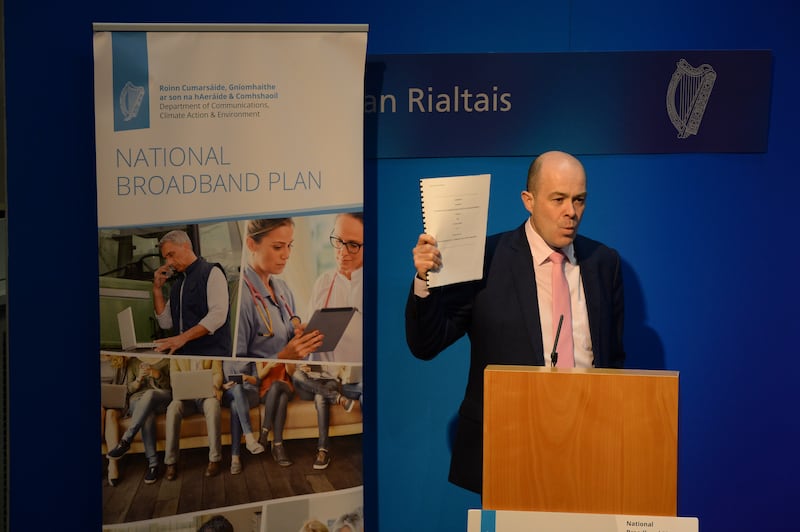The Government won approval from the EU Commission to provide State aid for the National Broadband Plan in 2019, having argued that vast areas of mainly rural Ireland did not have download speeds of 30mbps or greater, and commercial operators had no concrete plans to offer such a high-speed service in these places.
Controversially, the then cabinet overruled the objections of senior civil servants – based largely on cost – and approved the State aid package. A contract was awarded in November 2019 to the National Broadband Ireland consortium led by US businessman David McCourt.
Also that year the Department of Communications finalised a six-year mapping project dividing the State into two, colour-coded areas. The first was a blue area where commercial operators were offering high-speed services, or had concrete plans to do so. Under EU rules for State aid, subsidised broadband could not be offered where a high-speed commercial service was already operating.

The second area was an amber or “intervention” area, containing 540,000 premises where National Broadband Ireland would step in to provide high-speed fibre broadband. This number has now risen to 559,000 mostly due to new build housing.
READ MORE
However, over the past three years the availability of high-speed broadband across much of the country has changed significantly with commercial operators offering services in the amber, or intervention, area.
The changes would at least appear to question the basis for State intervention of €2.9 billion in the National Broadband Plan. The argument was that State aid was necessary as there were no commercial offerings available in large parts of the State.
[ Irish homeowners frustrated as national broadband rollout ‘leapfrogs’ areasOpens in new window ]
John Rooney, chief executive of Imagine.ie which claims to offer speeds of up to 150mbps, said the organisation was “extremely proud” to have built an extensive network over the past three years “with the opportunity to connect 1.2 million homes and businesses, of which over 380,000 are classified as amber on the National Broadband Ireland plan”.
He said speeds verified by ComReg showed the company was running “a credible, commercial alternative provider” with wireless technology now allowing speeds of up to 1GB “as we’ve already seen in Europe and the US”.
Imagine.ie is just one of a number of operators, estimated at about seven, now operating entirely lawfully in the amber areas as defined in the 2019 maps.
Another, Elon Musk’s Starlink satellite service offers coverage over the entire island. It achieved a download speed almost double that of Ireland’s combined fixed broadband average during the fourth quarter of 2021, according to Ookla, an independent specialist in network intelligence and measuring connectivity.
In contrast, National Broadband Ireland had connected 14,200 premises in June (17,220 currently), or about 22 per cent of the premises where it had offered connection. NBI chief executive Peter Hendrick told an Oireachtas committee in June: “While it is still early days in the deployment, in those deployment areas where the service has been available for more than six months, take-up rates have reached more than 30 per cent.”
The outcome is that while homes in some parts of the country are being told they cannot be connected under the National Broad Plan, because of the presence of a commercial offering, homes in other parts of the State are now being offered connections despite the presence of a commercial operator.
A spokesman for the Department of Communications said the department intended to rely on the 2019 maps. He said these maps were based on public consultation before the mapping exercise closed in at that time.
He acknowledged, however, that “there is nothing preventing any commercial operator providing new services in the intervention area – the amber area on the National Broadband Plan map”. But he said “that does not impact on the State aid decision and NBI is still permitted to build a future-proofed network to serve all of the premises in the identified intervention area for the next 25 years”.
“If an operator decides to invest in areas within the intervention area, they do so in the full knowledge that these areas are within the NBI’s deployment plan and within the scope of the NBP contract where a State-subsidised network will be built.”
He said the presence of other operators in the intervention area was “to be welcomed, as it provides important connectivity today for many people within the intervention area, while the NBP network is being built”.












